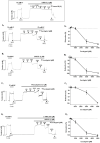Vasodilatory Effect of Alpinia officinarum Extract in Rat Mesenteric Arteries
- PMID: 35566064
- PMCID: PMC9104054
- DOI: 10.3390/molecules27092711
Vasodilatory Effect of Alpinia officinarum Extract in Rat Mesenteric Arteries
Abstract
Background: Alpinia officinarum (A. officinarum) is known to exhibit a beneficial effect for anti-inflammatory, anti-oxidant, and anti-hyperlipidemic effects. However, no sufficient research data are available on the cardiovascular effect of A. officinarum. Thus, in this study, we investigate whether A. officinarum extract has direct effects on vascular reactivity.
Methods: To examine whether A. officinarum extract affects vascular functionality, we measured isometric tension in rat mesenteric resistance arteries using a wire myograph. After arteries were pre-contracted with high-K+ (70 mM), phenylephrine (5 µM), or U46619 (1 µM), A. officinarum extract was treated.
Results: A. officinarum extract induced vasodilation in a concentration-dependent manner, and this effect was endothelium independent. To further investigate the mechanism, we incubated arteries in a Ca2+-free and high-K+ solution, followed by the cumulative addition of CaCl2 (0.01-2.5 mM) with or without A. officinarum extract (30 µg/mL). Pre-treatment of A. officinarum extract reduced the contractile responses induced by cumulative administration of Ca2+, which suggests that extracellular Ca2+ influx was inhibited by the treatment of A. officinarum extract. These results were associated with a reduction in phosphorylated MLC20 in VSMCs treated with A. officinarum extract. Furthermore, eucalyptol, an active compound of A. officinarum extract, had a similar effect as A. officinarum extract, which causes vasodilation in mesenteric resistance arteries.
Conclusion: A. officinarum extract and its active compound eucalyptol induce concentration-dependent vasodilation in mesenteric resistance arteries. These results suggest that administration of A. officinarum extract could exert beneficial effects to treat high blood pressure.
Keywords: Alpinia officinarum; Ca2+; eucalyptol; mesenteric resistance arteries; relaxation; vasodilation.
Conflict of interest statement
The authors declare no conflict of interest.
Figures







Similar articles
-
Vasorelaxant Effect of Trachelospermi caulis Extract on Rat Mesenteric Resistance Arteries.Molecules. 2022 Aug 19;27(16):5300. doi: 10.3390/molecules27165300. Molecules. 2022. PMID: 36014534 Free PMC article.
-
Vanillin Induces Relaxation in Rat Mesenteric Resistance Arteries by Inhibiting Extracellular Ca2+ Influx.Molecules. 2022 Dec 29;28(1):288. doi: 10.3390/molecules28010288. Molecules. 2022. PMID: 36615485 Free PMC article.
-
Vasodilatory Effect of Phellinus linteus Extract in Rat Mesenteric Arteries.Molecules. 2020 Jul 10;25(14):3160. doi: 10.3390/molecules25143160. Molecules. 2020. PMID: 32664327 Free PMC article.
-
Ezetimibe Induces Vasodilation in Rat Mesenteric Resistance Arteries through Inhibition of Extracellular Ca2+ Influx.Int J Mol Sci. 2023 Sep 12;24(18):13992. doi: 10.3390/ijms241813992. Int J Mol Sci. 2023. PMID: 37762296 Free PMC article.
-
Potential Neuroprotective Effects of Alpinia officinarum Hance (Galangal): A Review.Nutrients. 2024 Oct 4;16(19):3378. doi: 10.3390/nu16193378. Nutrients. 2024. PMID: 39408345 Free PMC article. Review.
Cited by
-
Influence of Thermal Treatment on the Composition of Alpinia officinarum Rhizome.Int J Mol Sci. 2024 Mar 24;25(7):3625. doi: 10.3390/ijms25073625. Int J Mol Sci. 2024. PMID: 38612437 Free PMC article.
References
-
- Benjamin E.J., Muntner P., Alonso A., Bittencourt M.S., Callaway C.W., Carson A.P., Chamberlain A.M., Chang A.R., Cheng S., Das S.R., et al. Heart disease and stroke statistics-2019 update: A report from the american heart association. Circulation. 2019;139:e56–e528. doi: 10.1161/CIR.0000000000000659. - DOI - PubMed
-
- Brown I.A.M., Diederich L., Good M.E., DeLalio L.J., Murphy S.A., Cortese-Krott M.M., Hall J.L., Le T.H., Isakson B.E. Vascular smooth muscle remodeling in conductive and resistance arteries in hypertension. Arterioscl. Throm. Vas. 2018;38:1969–1985. doi: 10.1161/ATVBAHA.118.311229. - DOI - PMC - PubMed
MeSH terms
Substances
Grants and funding
LinkOut - more resources
Full Text Sources
Miscellaneous

